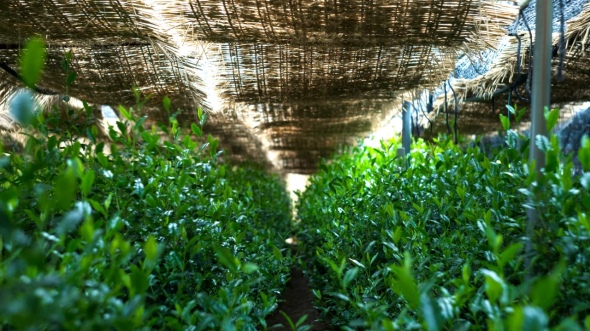
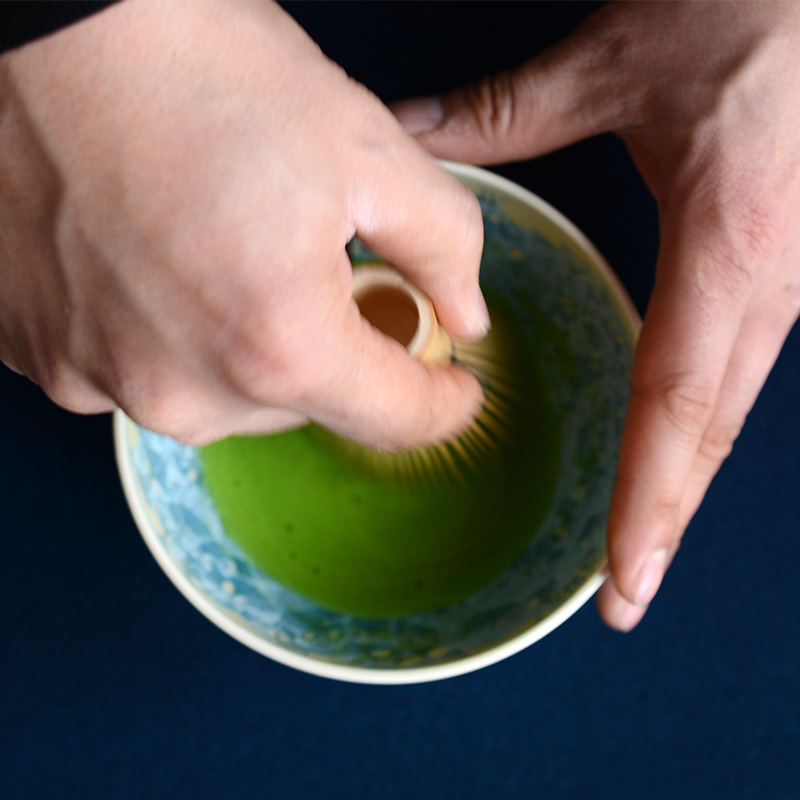
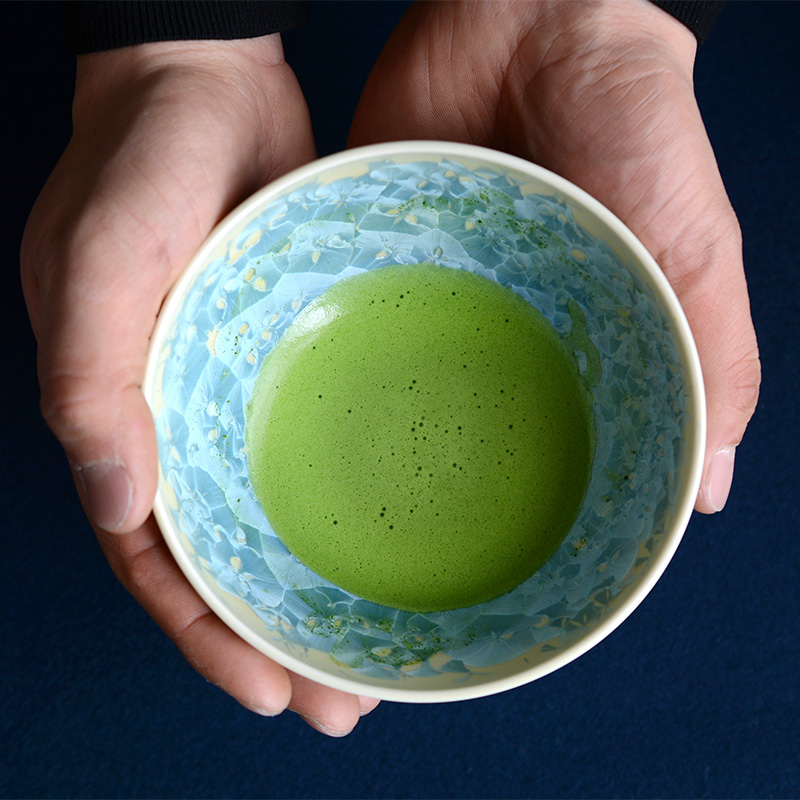

What is Matcha?
Matcha is a Japanese powdered green tea, traditionally served at tea ceremonies. Matcha dates back to the early Kamakura period (1185-1333) when a Buddhist monk brought the first tea plants from China to Japan. Tea is now grown in severeal areas in Japan, and one of the most prominent of all is Uji.
Uji Tea is a high-quality tea cultivated in 4 prefectures: Kyoto, Nara, Shiga, and Mie. It is processed in Kyoto using an ancient, traditional processing method developped in Uji centuries ago, so Uji matcha is well known for its long history, especially high quality and delicious flavors, that once you taste, you will never forget.
How is Matcha grown?
Matcha is made of tea leaves tended with special care, grown under shades. This means that once the new buds start to appear, the tea bushes are covered to avoid direct sunlight. This prevents L-Theanine from turning into Catechin, and the tea will taste mild, less astringent, and will be rich in Umami. This is how gyokuro tea leaves are grown as well.
How is Matcha made
After steaming and drying, the leaves are ready. At this stage, the tea is called tencha. After a careful selection, only the best leaves are ground into matcha powder under granite millstones. This process is now automated, but even electric granite mills can grind only 40g per hour. The grounded tea is around 5microns in size, which makes matcha an extremely fine powder. Actually, the finer the leaves are grounded, the higher rank the matcha is. After processing, no additional flavoring is added. What we taste in our matcha, whether it's for everyday consumption or ceremonial purposes, is the pure flavour of tea leaves.
HEALTH BENEFITS
Green teas, in general, have several important health benefits. You can read more about them in a previous blog post: here, but matcha is special even amongst green teas, since we consume the whole leaves, thus all those benefits are intensified.
How much caffeine in a bowl of matcha?
Among all the green teas, matcha contains the most caffeine. Coffee, depending on how we prepare it, might contain 60-150mg caffeine, while matcha prepared in a traditional way - 2g (0.4 US tsp) of the powder whisked in 70ml (2.3 fl. oz.) water - contains around 50mg caffeine. It is definitely less than what you find in your coffee, but as caffeine from matcha is absorbed slower, it is easier on the heart, and its effect is remarkably more long-lasting than of coffee's.
High Vitamin content
Green tea contains a lot of vitamins, but some of them are non water-soluble, so they are lost when drinking tea infusions. When drinking matcha however, by consuming the leaves themselves, these vitamins are able to enter the digestive system, and they can take full effect. Vitamin A (β-carotene) for instance, that has strong skin moisturizing effect while also improves respiratory and digestive organ functions, is such a non water-soluble vitamin, that we can make full use of by drinking our matcha.
Water-soluble vitamins and minerals you can benefit from by drinking matcha as well as green tea:
Vitamin content
- Vitamin E
- has anti-aging effects
- Vitamin B1
- turns sugar into energy
- Vitamin B2
- improves eyesight
Mineral content
- Calcium, Potassium, etc.
- boosts metabolism
- prevents bad breath
Minowarin content
- helps lowering blood glucose level
Amino Acids
- L-Theanine
- stimulates brain function
- GABA
- helps burn fat
- lowers blood pressure and the risk of dementia
- Catechin
- helps prevent cell damage
Nutrition Facts per 100 g
- Energy: 324 Kcal
- Protein: 21 g
- Total fat: 5.3 g
- Saturated fat: 0 g
- Trans fatty acid: 0 g
- Carbohydrates: 38.5 g
- Sugars: 0 g
- Sodium: 3 mg
Drinking 1-2 bowls of matcha daily can be very beneficial for one’s body, but due to its strong stimulating effect, more than 3-4 cups a day is not recommended.
Expiration and storage
In Japan, the ‘best-before’ date for matcha is controlled by law: genuine, quality matcha is best within 6-8 months after production.
After opening a can it is best to consume the matcha within one month.
Matcha doesn’t spoil, but with time (especially after exposure to oxygen) it loses flavor and color. To prevent that from happening faster, it is crucial to store it properly. We suggest you leave the matcha in its original packaging, and sift only the amount you will consume within a couple of days.
Daily use: Store in a dry, cool place. No need to put it in refrigerator if the room temperature is 20-25 ℃ or lower.
Used twice a week (or less):
- Store in refrigerator
- Before drinking, let the can sit unopened for 1-2 hours, until it is about room temperature, to prevent precipitation.
Always store matcha away from strong spices, for it easily takes up other flavors.
Don’t be confused by the ‘best-before-date’
- In Japan, unlike in most countries, the date is given in reverse order. From left to right: year, month and day (YY/MM/DD).
- Some manufacturers do not include the day, only year and month (YYYY/MM).
Preparing Matcha
Matcha tools:
● Chasen (tea whisk - indispensable) ● Chawan (tea bowl) ● Chashaku (tea scoop) ● Natsume ● Chakin ● Samashi (for Iced Matcha) ● Tea Tray
● matcha sifter ● Teaspoon (for sifting) ● Matcha caddy with sifter ● pitcher or measuring cup
The two ceremonial ways to prepare matcha:
▶︎ USUCHA (thin tea) - for daily use

Step 1) Warm up your tea bowl with hot water, then dry it using a clean cloth.
Step 2) Sift 2 g (0.4 US tsp or 2 chashaku scoop) of matcha powder into the warm and dry tea bowl.
Step 3) Pour 75 ml (2.53 fl. oz.) 80℃ (176°F) water over the matcha powder.
Step 4) Whisk with a suitable chasen (tea whisk) until foamy.
▶︎ KOICHA (thick tea) - Highest grade matcha made for ceremonies
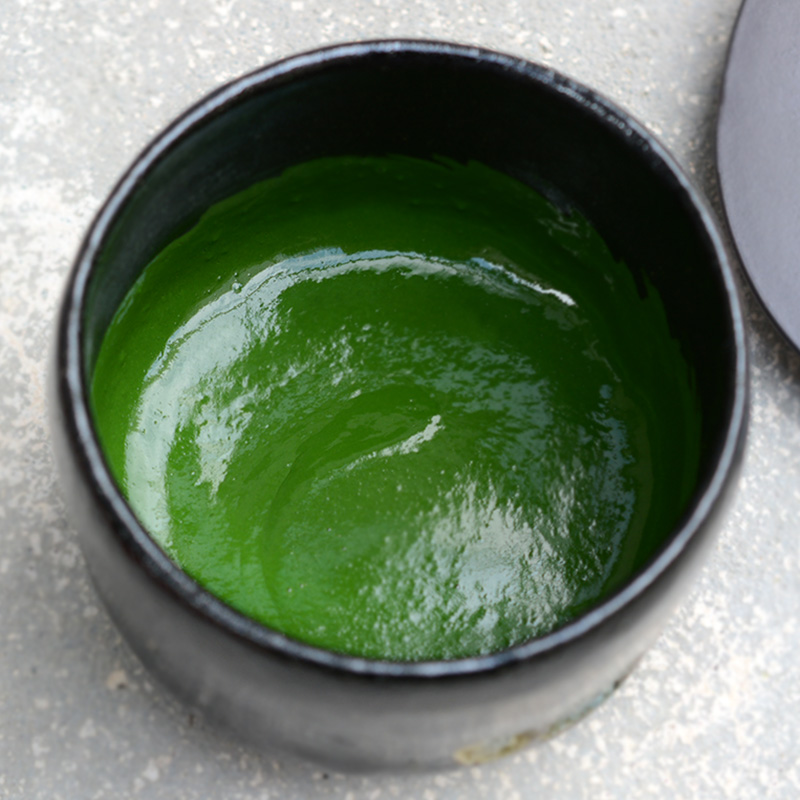
Step 1) Warm up tea bowl with hot water, then dry it with a clean cloth.
Step 2) Sift 4 g (0.8 US tsp or 4 chashaku scoop) matcha powder into the warm and dry tea bowl.
Step 3) Pour 15 ml (0.5 fl. oz.) 80℃ (176°F) water over the matcha powder.
Step 4) Gently knead with a suitable chasen (tea whisk) until all lumps are gone.
Step 5) Repeat step 3 and 4.
The two ways to prepare Iced Matcha
▶︎ ICED MATCHA whisked with hot water
Advantage: You can make a beautifully frothy matcha whisking it in hot water compared to cool water. Don't be afraid to use hot water, ice will quickly cool your matcha down.
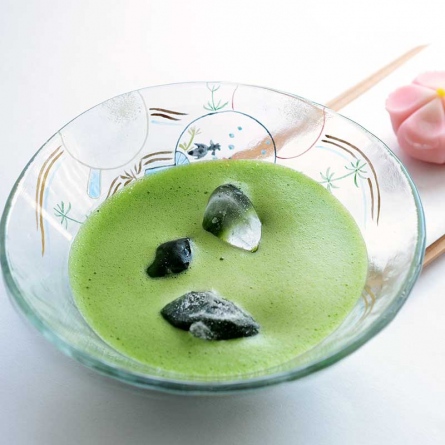
Step 1) Sift 2 g (0.4 US tsp or 2 chashaku scoop) of matcha powder into a larger size yuzamashi, called samashi.
Step 2) Pour 60 ml (2.3 fl. oz.) 80-85℃ (176°F) water over the matcha powder.
Step 3) Whisk with a suitable chasen (tea whisk) until foamy.
Step 4) Pour it in your teabowl, on ice.
▶︎ ICED MATCHA whisked with tepid or cold water
Advantage: You need only one teabowl to prepare this Iced Matcha. But be aware, not all matchas are suitable for Iced Matcha.
 Step 1) Sift 2 g (0.4 US tsp, 1 teaspoon, or 2 chashaku scoops) matcha powder into your tea bowl and mix it until creamy with a little - 15-20ml (0.5-0.7 fl.oz) - lukewarm water.
Step 1) Sift 2 g (0.4 US tsp, 1 teaspoon, or 2 chashaku scoops) matcha powder into your tea bowl and mix it until creamy with a little - 15-20ml (0.5-0.7 fl.oz) - lukewarm water.
Step 2) Pour 40 ml (1.2 fl.oz) cold water over the matcha 'cream'.
Step 3) Whisk with a suitable chasen (tea whisk) until foamy (with tepid water you cannot whisk as even and thick foam on your matcha as using hot water, but that does not affect its taste)
Step 4) Add ice.
TIPs for making Matcha:
- Use soft water to prepare any kind of tea. Using spring water or mineral water with low natrium and calcium content is best. (High natrium and calcium content takes the pep out of tea.) If using tap water, use a water purifier first.
- Boil the water first, then let it cool back to the desired temperature.
- Sift the matcha powder before using, sifting the matcha into the tea bowl prevents clotting.
- The volumes and temperature we are suggesting is the ceremonial way to prepare tea, but you can always make slight changes if it fits your taste better.
- When whisking matcha, use upward and downward wrist movements, do not swirl the tea around.
- It is best to consume the matcha before it starts to cool down, since it gets bitter as it cools.
- ICED MATCHA - For some refreshment, drink your matcha iced. Just prepare it as usual (with hot water) and pour it over ice. Some special matcha blends are also suitable for preparing with cold water (Matcha Suzukumo, Matcha Awaraku).
Various matcha blends in OUR offer
At Sazen Tea, we offer only the finest Uji matcha produced exclusively in Japan. The brands we select are high in demand for their premium quality and long history. All the producers we deal with have their own tea factories and granite mills, where they grind only the best quality tea leaves.
Marukyu-Koyamaen
One of Japan's most prominent tea producers, with a long history of tea manufacturing and many prized teas. Their teas are often selected by “iemoto”, the highest rank tea masters and Japanese restaurants.
➢ Marukyu-Koyamaen matcha in our portfolio: 51 (plus seasonal)
Hekisuien
Hekisuien has been providing high-quality Uji Matcha since 1867.
Their logo, the Tengu - a divine, half demonic creature from Japanese folklore, is a statement, and refers to the main principle of Tea Ceremony: Be modest and humble, do not let yourself become conceited or boastful.
➢ Hekisuien matcha in our portfolio: 16
Horii Shichimeien
Horii Shichimeien has been the owner of “Okunoyama” tea garden, the only one of the Seven Famous Gardens (Uji Shichimeien) that has survived.
Engaging in the whole process of tea manufacturing from picking to grinding, they provide delicious Uji matcha.
➢ Horii Shichimeien matcha in our portfolio: 16 (plus seasonal)
Hokoen
This more than 150 years old tea manufacturing company offers a large selection of different kinds of matcha.
From entry-level to the highest grade, usucha to koicha, everyone can find their favorite whether they are beginner or experienced matcha lovers.
➢ Hokoen matcha in our portfolio: 9
Yamamasa-Koyamaen
Uji tea manufacturer with its own tea gardens, established in 1861. With their motto, "Taste comes first" they refer to the hard work they put in to create delicious tea blends of the highest quality.
➢ Yamamasa-Koyamaen matcha in our portfolio: 30 (plus seasonal)
When looking to try a new matcha, it might be a daunting task to choose the right one. Here are some recommendations from each company in our portfolio, to help you find your absolute favorite:
Matcha Wako BY MARUKYU-KOYAMAEN
Wako is Koyamaen's highest grade usucha, with its intense, full-bodied and round flavor, minimal tartness, long-lingering, pleasant, sweet after-taste.
Matcha Tenko BY HEKISUIEN
Tenko envelops its taster with sweetness and gentle, yet pronounced mildness. It is a great tea which can be prepared both as usucha and koicha.
Matcha Narino BY HORII SHICHIMEIEN
A single origin matcha made only using the leaves of the tea plant called Narino, that is grown in Horii Shichimeien’s own tea garden. Its exquisite fragrance instantly captivates, exuding fantastic freshness and a sweet, creamy flavor.
Matcha Shoukaku by HOKOEN
Shoukaku is a crystal-clear, uniquely delicious, concentrated tea essence. It’s a great choice for those looking for something special in a koicha, exceeding the ordinary.
To help you get started, you can also choose a beginner's matcha set to get everything you need to enjoy a perfect cup of matcha.



